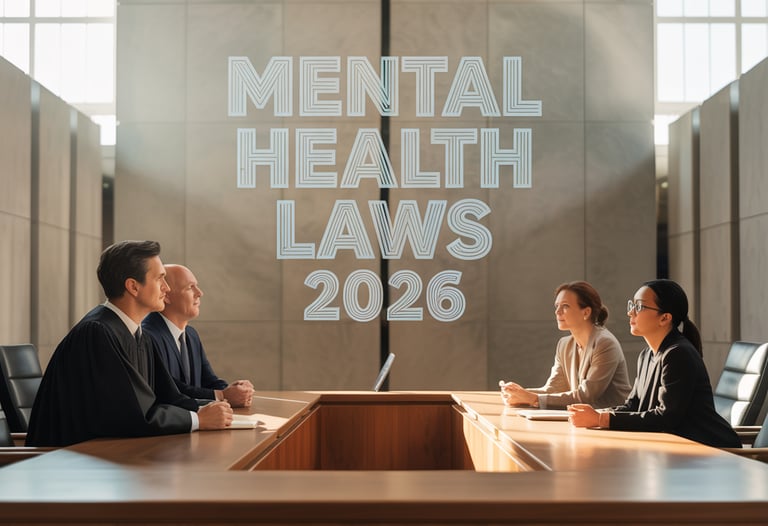The Changing Landscape of Mental Health Law in 2026
As mental health laws evolve in 2026, proper documentation is more important than ever. From updated parity rules to new telehealth requirements, practices must show compliance through the way they record, track, and manage patient care. This article explains the latest legal changes while highlighting how the right forms—such as consent documents, medication trackers, and treatment logs—help protect your practice, support insurance appeals, and ensure patients receive equitable care. Staying informed isn’t enough; using clear, compliant forms is what keeps your practice safe and sustainable.
9/29/20252 min read


Key Mental Health Law Updates Every Practice Should Know in 2026
Mental health professionals practice in a landscape where the law is constantly shifting. These changes do not exist in theory—they shape daily operations, influence access to care, and determine how practices are reimbursed. As 2026 begins, several important laws and regulations are at the center of the conversation. Understanding them is essential for staying compliant and safeguarding both patients and practices.
The Mental Health Parity and Addiction Equity Act (MHPAEA) continues to drive significant change. In 2024, federal agencies issued strengthened rules requiring health plans to demonstrate true parity between behavioral health and medical services. These updates focus on non-quantitative treatment limitations such as prior authorization requirements, step therapy policies, and provider network restrictions. While portions of the rule are under nonenforcement review, the expectation of parity has not disappeared. Clinicians and compliance officers should assume these standards will eventually be enforced and prepare accordingly.
The Final Parity Rule of 2024, published by the Departments of Labor, Health and Human Services, and the Treasury, is especially important. This rule requires insurers to conduct and maintain comparative analyses proving that behavioral health care is not subjected to stricter rules than comparable medical care. Implementation deadlines were originally staged for 2025 and 2026, but enforcement has been paused as the agencies review feedback. Even so, practices should treat these standards as active and integrate them into compliance planning.
On the legislative side, several bills introduced in Congress in 2025 are worth watching. The Pursuing Equity in Mental Health Act (H.R. 2904) aims to reduce disparities in access, particularly for youth and communities of color. The Mental Health Infrastructure Improvement Act of 2025 (H.R. 3266) proposes loan programs to build or renovate mental health and substance use disorder facilities, as well as expand telehealth infrastructure. In the Senate, S. 683 would authorize additional Medicare payments for providers working in federally designated mental health shortage areas. None of these proposals have yet become law, but their passage would significantly reshape reimbursement and resource allocation in the years ahead.
Telehealth also remains under active revision. Medicare rules requiring an in-person visit within six months of a telehealth appointment and annually thereafter have been loosened. Federally Qualified Health Centers and Rural Health Clinics, in particular, have been granted flexibility through January 1, 2026. Many pandemic-era waivers are set to expire, however, so practices must monitor updates from the Centers for Medicare and Medicaid Services and adjust their telehealth policies, consents, and technology standards accordingly.
Finally, funding is a looming concern. The Mental Health Block Grant and the Substance Abuse Prevention and Treatment Block Grant face possible reductions as Congress debates the federal budget. These grants support vital community programs and public mental health services. Cuts could create downstream effects on access, staffing, and reimbursement, particularly for practices that serve Medicaid populations or rely on grant support.
Taken together, these laws and regulations paint a picture of both opportunity and challenge for 2026. The push for parity through the MHPAEA, the promise of new resources through pending federal legislation, the evolving flexibility of telehealth, and the uncertainty of behavioral health funding all create a complex environment for providers. Yet at the center of compliance is one simple truth: documentation matters. The right forms—whether for telehealth consent, treatment planning, or medication tracking—remain the foundation for compliance, appeals, and patient safety.
For mental health professionals, 2026 is not just another year of change. It is a reminder that the intersection of law and care is where the quality of practice is defined. By staying informed, using accurate forms, and preparing proactively, clinicians can navigate this shifting landscape with confidence and continue to protect the patients who depend on them.
